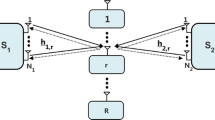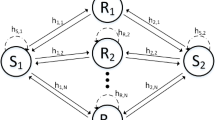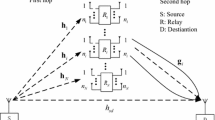Abstract
In this paper, we study end-to-end performance of transmit antenna selection (TAS) and maximal ratio combining (MRC) in dual hop amplify-and-forward relay network in flat and asymmetric Nakagami-m fading channels. In the network, source and destination communicate by the help of single relay and source-destination link is not available. Source and destination are equipped with multiple antennas, and relay is equipped with single antenna. TAS and MRC are used for transmission at the source and reception at the destination, respectively. The relay simply amplifies and forwards the signal sent by the source to the destination by using channel state information (CSI) based gain or fixed gain. By considering relay location, for CSI based and fixed relay gains, we derive closed-form cumulative distribution function, moments and moment generating function of end-to-end signal-to-noise ratio, and closed-form symbol error probability expression. Moreover, asymptotical outage probability and symbol error probability expressions are also derived for both CSI based and fixed gains to obtain diversity order of the network. Analytical results are validated by the Monte Carlo simulations. Results show that diversity order is minimum of products of fading parameter and number of antennas at the end in each hop. In addition, for optimum performance the relay must be closer to the source when the diversity order of the first hop is smaller than or equal to that of the second hop.
Similar content being viewed by others
References
Sendonaris, A., Erkip, E., & Aazhang, B. (1998). Increasing uplink capacity via user cooperation diversity. In Proceedings of the IEEE international symposium information theory (ISIT’98) (p. 156). Cambridge, MA.
Laneman, J.N., & Wornell, G.W. (2000). Energy-efficient antenna sharing and relaying for wireless networks. IEEE wireless communication and network conference (WCNC’00) (pp. 7–12). Chicago, IL.
Laneman J.N., Tse D.N.C., Wornell G.W. (2004) Cooperative diversity in wireless networks: Efficient protocols and outage behavior. IEEE Transactions on Information Theory 50(12): 3062–3080
Hasna M.O., Alouini M.-S. (2003) End-to-end performance of transmission systems with relays over Rayleigh-fading channels. IEEE Transactions on Wireless Communications 2: 1126–1131
Hasna M.O., Alouini M.-S. (2004) A performance study of dual-hop transmissions with fixed gain relays. IEEE Transactions on Wireless Communications 3: 1963–1968
Hasna, M.O., & Alouini, M.-S. (2002). Performance analysis of two-hop relayed transmission over Rayleigh fading channels. In Proceedings of the IEEE vehicular technology conference (VTC’02) (pp. 1992–1996). Vancouver, BC, Canada.
Zhao Q., Li H., Wang P. (2008) Performance of cooperative relay with binary modulation in Nakagami-m fading channels. IEEE Transactions on Vehicular Technology 57(5): 3310–3315
Zhao Y., Adve R., Lim T.J. (2007) Improving amplify-and-forward relay networks: Optimal power allocation versus selection. IEEE Transactions on Wireless Communications 6(8): 3114–3123
Zhu Y., Xin Y., Kam P.Y. (2008) Outage probability of Rician fading relay channels. IEEE Transactions on Vehicular Technology 57(4): 2648–2652
Lee I.-H., Kim D. (2008) Probability of SNR gain by dual-hop relaying over single-hop transmission in SISO Rayleigh fading channels. IEEE communications letters 12(10): 734–736
Ribeiro A., Cai X., Giannakis G.B. (2005) Symbol error probabilities for general cooperative links. IEEE Transactions on Wireless Communications 4(3): 1264–1273
Telatar I.E. (1999) Capacity of multi-antenna Gaussian channels. European Transactions on Telecommunications 10: 585–595
Foschini G.J., Gans M.J. (1998) On limits of wireless communications in a fading environment when using multiple antennas. Wireless Personal Communications 6: 311–335
Alamouti S.M. (1998) A simple transmit diversity technique for wireless communications. IEEE Journal on Selected Areas in Communications 16: 1451–1458
Thoen S., Vander Perre L., Gyselinckx B., Engels M. (2001) Performance analysis of combined transmit-SC/receive-MRC. IEEE Transactions on Communications 49: 5–8
Molisch A.F. (2003) MIMO systems with antenna selection-an overview. Radio and Wireless Conference 37(20): 167–170
Cai X., Giannakis G. (2004) Performance analysis of combined transmit selection diversity and receive generalized selection combining in Rayleigh fading channels. IEEE Transactions on Wireless Communications 3: 1980–1983
Molisch A.F. (2005) Wireless communications. Wiley, London
Eng T., Kong N., Milstein L.B. (1996) Comparison of diversity combining techniques for Rayleigh-fading channels. IEEE Transactions on Communications 44: 1117–1129
Simon M.K., Alouini M.-S. (2005) Digital communication over fading channels (2nd ed.). Wiley, London
Chen Z., Yuan J., Vucetic B. (2005) Analysis of transmit antenna selection/maximal-ratio combining in Rayleigh fading channels. IEEE Transactions on Vehicular Technology 54: 1312–1321
Louie R.H.Y., Li Y., Suraweera H.A., Vucetic B. (2009) Performance analysis of beamforming in two hop amplify and forward relay networks with antenna correlation. IEEE Transactions on Wireless Communications 8(6): 3132–3141
Lee I.-H., Kim D. (2008) End-to-end BER analysis for dual-hop OSTBC transmissions over Rayleigh fading channels. IEEE Transactions on Communications 56(3): 347–351
Kim J.-B., Kim D. (2008) BER analysis of dual-hop amplify-and-forward MIMO relaying with best antenna selection in Rayleigh fading channels. IEICE Transactions on Communications E91-B: 2772–2775
Yılmaz, A., & Kucur, O. (2010). Error performance of joint transmit and receive antenna selection in two hop amplify-and-forward relay system over Nakagami-m fading channels. In Proceedings of IEEE international symposium on personal, indoor and mobile radio communications (PIMRC’10) (pp. 2198–2203). İstanbul, Turkey.
Chen, S., Wang, W., Zhang, X., & Zhao, D. (2009). Performance of amplify-and-forward MIMO relay channels with transmit antenna selection and maximal-ratio combining. In Proceedigs of IEEE wireless communication and network conference (WCNC’ 09) (pp. 1–6). Budapest, Hungary.
Yılmaz, A., & Kucur, O. (2010). Performance analysis of two hop amplify and forward relay system with transmit antenna selection and maximal-ratio combining over Nakagami-m fading channels. In Proceedings of IEEE 18th signal processing and communication applications conference (SIU) (pp. 653–656). 22–24, Diyarbakır, Turkey. (In Turkish).
Duong, T. Q., Zepernick, H.-J., Tsiftsis, T.A., & Vo, N. Q. B. (2010). Performance analysis of amplify-and-forward MIMO relay networks with transmit antenna selection over Nakagami-m channels. IEEE 21st international symposium on personal indoor and mobile radio communication (PIMRC) (pp.368–372). İstanbul, Turkey.
Mark J., Zhuang W. (2003) Wireless communications and networking. Prentice Hall, New Jersey
Gradshteyn I.S., Ryzhik I.M. (2007) Table of integrals, series, and products (7th ed.). Academic Press, San Diego, CA
David H.A., Nagaraja H.N. (2003) Order Statistics (3rd ed.). Wiley, London
Stüber G.L. (2001) Principles of Mobile Communication, 2nd edition. Kluwer Academic Publishers, Dordrecht
Coşkun, A.F., Kucur, O. & Altunbaş, İ. Performance analysis of space-time block codes with transmit antenna selection in Nakagami-m fading channels. Wireless Personal Communications (Accepted, to be published).
McKay M.R., Grant A.J., Collings I.B. (2007) Performance analysis of MIMO-MRC in double-correlated Rayleigh environments. IEEE Transactions on Communications 55(3): 497–507
Win M.Z., Mallik R.K., Chrisikos G. (2003) Higher order statistics of antenna subset diversity. IEEE Transactions on Wireless Communications 2(5): 871–875
Wang Z., Giannakis G.B. (2003) A simple and general parameterization quantifying performance in fading channels. IEEE Transactions on Communications 51(8): 1389–1398
Wang T., Cano A., Giannakis G.B., Laneman J.N. (2007) High-performance cooperative demodulation with decode-and-forward relays. IEEE Transactions on Communications 55(7): 1427–1438
Xu F., Lau F.C.M., Yue D.-W. (2010) Diversity order for amplify-and-forward dual-hop systems with fixed-gain relay under Nakagami fading channels. IEEE Transactions on Wireless Communications 9(1): 92–98
Papoulis A. (1991) Probability, random variables, and stochastic processes (3rd ed.). McGraw-Hill, New York
Oldham K.B., Myland J., Spanier J. (2008) An atlas of functions with equator, the atlas function calculator (2nd ed.). Springer, Berlin
Author information
Authors and Affiliations
Corresponding author
Rights and permissions
About this article
Cite this article
Yılmaz, A., Kucur, O. Performance of Transmit Antenna Selection and Maximal-Ratio Combining in Dual Hop Amplify-and-Forward Relay Network over Nakagami-m Fading Channels. Wireless Pers Commun 67, 485–503 (2012). https://doi.org/10.1007/s11277-011-0391-7
Published:
Issue Date:
DOI: https://doi.org/10.1007/s11277-011-0391-7




